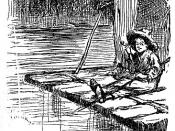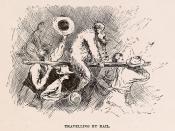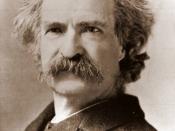The novel The Adventures of Huckleberry Finn, written by Samuel L. Clemens, whose pen name was Mark Twain, presents the evils of southern societies during the pre-Civil War period in America. Clemens, a well-respected author, "...began writing The Adventures of Huckleberry Finn in 1876 and, after several stops and starts, completed it in 1883" (19). This novel revolves around the theme of slavery versus freedom, and was published at a time when most southern landowners still "owned" slaves. Huck Finn is a novel that incorporates the struggles of a young boy, Huck Finn, with that of a cruel, careless world, on his travel down the Mississippi River in attempt at finding his own identity. In this essay, I will present textual evidence that proves that the Seven Deadly Sins are directly associated with the types of evil in the novel, making Huck's world one of violence, terror, and death.
The Seven Deadly Sins will be discussed according to their significance throughout the novel, beginning with: 1.) Pride; 2.) Avarice and Sloth; 3.) Gluttony and Wrath; and 4.) Envy and Lust.
Clemens' main character, Huck Finn, experiences a great deal of violence throughout the novel as a direct result of the most significant Deadly Sin, Pride. Huck's father, Pap, is a drunkard who continuously exemplifies the sin of Pride. Pap finds extreme Pride in the "white man" with the legality of slavery. An example of his Pride is seen when an inebriated Pap verbally attacks free blacks in the States. He states, "It was 'lection day, and I was just about to go and vote myself, if I war'nt too drunk to get there; but when they told me there was a State in this country where they'd let a nigger vote, I drawed out. I says I'll never...


